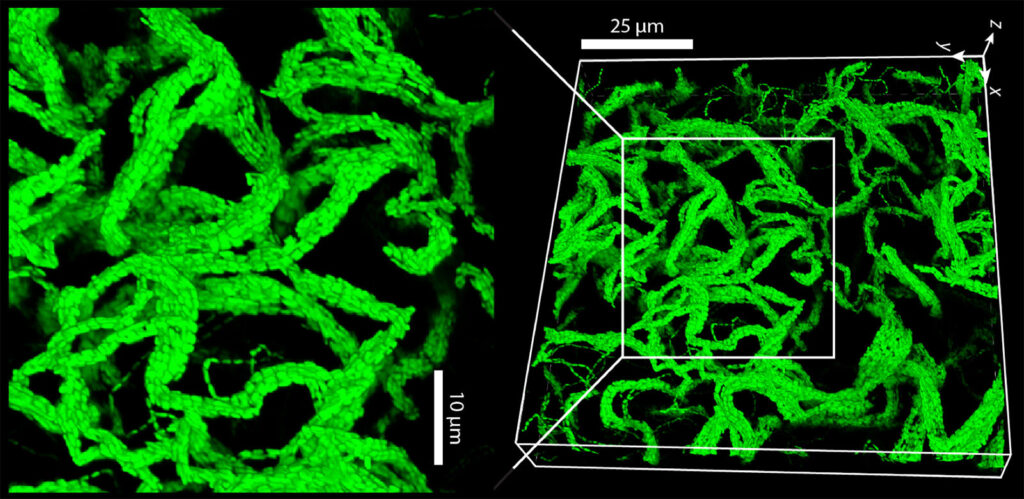Scientists at Caltech and Princeton University have discovered that bacterial cells growing in a solution of polymers, such as mucus, form long cables that buckle and twist on each other, building a kind of “living Jell-O.”
The finding could be particularly important to the study and treatment of diseases such as cystic fibrosis, in which the mucus that lines the lungs becomes more concentrated, often causing bacterial infections that take hold in that mucus to become life threatening. This discovery could also have implications in studies of polymer-secreting conglomerations of bacteria known as biofilms—the slippery goo on river rocks, for example—and in industrial applications where they can cause equipment malfunctions and health hazards.
The work is described in a paper published on January 17 in the journal Science Advances.
“We’ve discovered that when many bacteria grow in fluids containing spaghetti-like molecules called polymers, such as mucus in the lungs, they form cable-like structures that intertwine like living gels,” says Sujit Datta, a professor of chemical engineering, bioengineering, and biophysics at Caltech and corresponding author of the new paper. “And, interestingly, there are similarities between the physics of how these structures form and the microscopic physics underlying many nonliving gels, like Purell or Jell-O.”
Datta recently moved to Caltech from Princeton University. One of his graduate students at Princeton, Sebastian Gonzalez La Corte, is lead author of the paper. He and Datta had been interested in how mucus concentration changes in the lungs and guts of cystic fibrosis patients—in whom more polymers than usual are present. Working with mucus samples provided by colleagues at MIT, Gonzalez La Corte grew E. coli bacteria (commonly used in laboratory studies) in regular liquid and in cystic fibrosis-like samples and then observed the specimens under a microscope to watch how the bacterial cells grew in each case.
He focused on cells that had lost the ability to swim, as is the case for many bacteria in nature. Under normal circumstances, when such a cell divides into two, the resulting cells separate and diffuse away from each other. However, Gonzalez La Corte found that in a polymeric solution, the copied cells remained stuck to each other, end to end.
“As cells continue to divide and stick to each other, they start to form these beautiful long structures that we call cables,” Gonzalez La Corte says. “At some point, they actually bend and fold on each other and form an entangled network.”
The team found that the cables continue to elongate and grow as long as the cells have the nutrients they need, eventually creating chains that are thousands of cells long.
Subsequent experiments showed that it does not seem to matter which bacterial species are introduced, nor does the type of organic polymer solution make a difference; once enough polymer surrounds the bacterial cells, the cables grow. The researchers even saw the same result with bacteria in synthetic polymers.

Although the initial motivation for the study was to better understand the growth of infections in patients with cystic fibrosis, the findings are more broadly relevant. Mucus plays an important role in the human body, not only in the lungs but also in the gut and in the cervicovaginal tract. And Datta says the work is also important in the context of biofilms, groupings of bacteria that grow an encapsulating polymer matrix of their own. There are biofilms in the human body, such as dental plaque, but they are also extremely common in soil and in industrial settings, where they can damage equipment and cause health hazards.
“That polymer matrix that they’ve secreted is what makes biofilms so tough to remove from surfaces and treat with antibiotics,” Datta says. “Understanding how cells grow in that matrix could be key to discovering how to better control biofilms.”
Understanding the Physics Behind the Cables
Through carefully designed experiments, the team found that the external pressure exerted by the polymers surrounding the dividing cells is what forces the cells together and holds them in place. In physics, such an attractive force that is under the control of an outside pressure is called a depletion interaction. Gonzalez La Corte used the theory of depletion interaction to create a theoretical model of bacterial cable growth. The model can predict when a cable will survive and grow in a polymeric environment.
“Now we can actually use established theories from polymer physics, which were developed for completely different things, in these biological systems to quantitatively predict when these cables will arise,” Datta says.
Why Do the Bacteria Form These Cables?
“We discovered this interesting, unusual, very unexpected phenomenon,” Datta says. “We can also explain why it happens from a mechanistic, physics perspective. Now the question is: What are the biological implications?”
Interestingly, there are two possibilities: The bacteria could be clumping together to form this network of living gel in an effort to make themselves larger and therefore more difficult for immune cells to engulf and destroy. Alternately, cable formation could actually be harmful to the bacteria. After all, the secretions from the host cause the bacteria to build the cables. “Mucus isn’t static; for example, in the lungs, it’s being constantly swept up by little hairs on the surface of the lungs and propelled upward,” Datta says. “Could it be that when bacteria are all clumped together in these cables, it’s actually easier to get rid of them—to expel them out of the body?”
For now, no one knows which possibility is correct, and Datta says that is what makes this project remain interesting. “Now that we have found this phenomenon, we can frame these new questions and design further experiments to test our suspicions,” he says.


